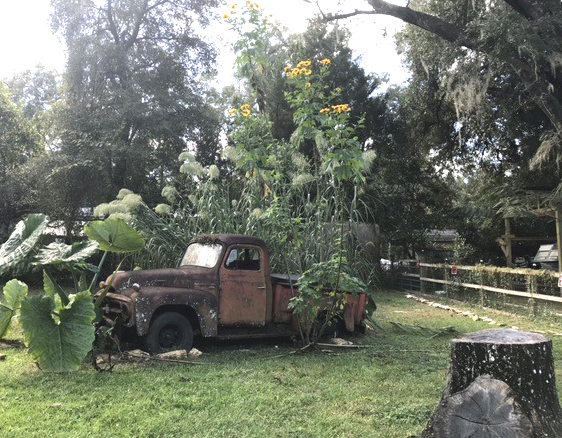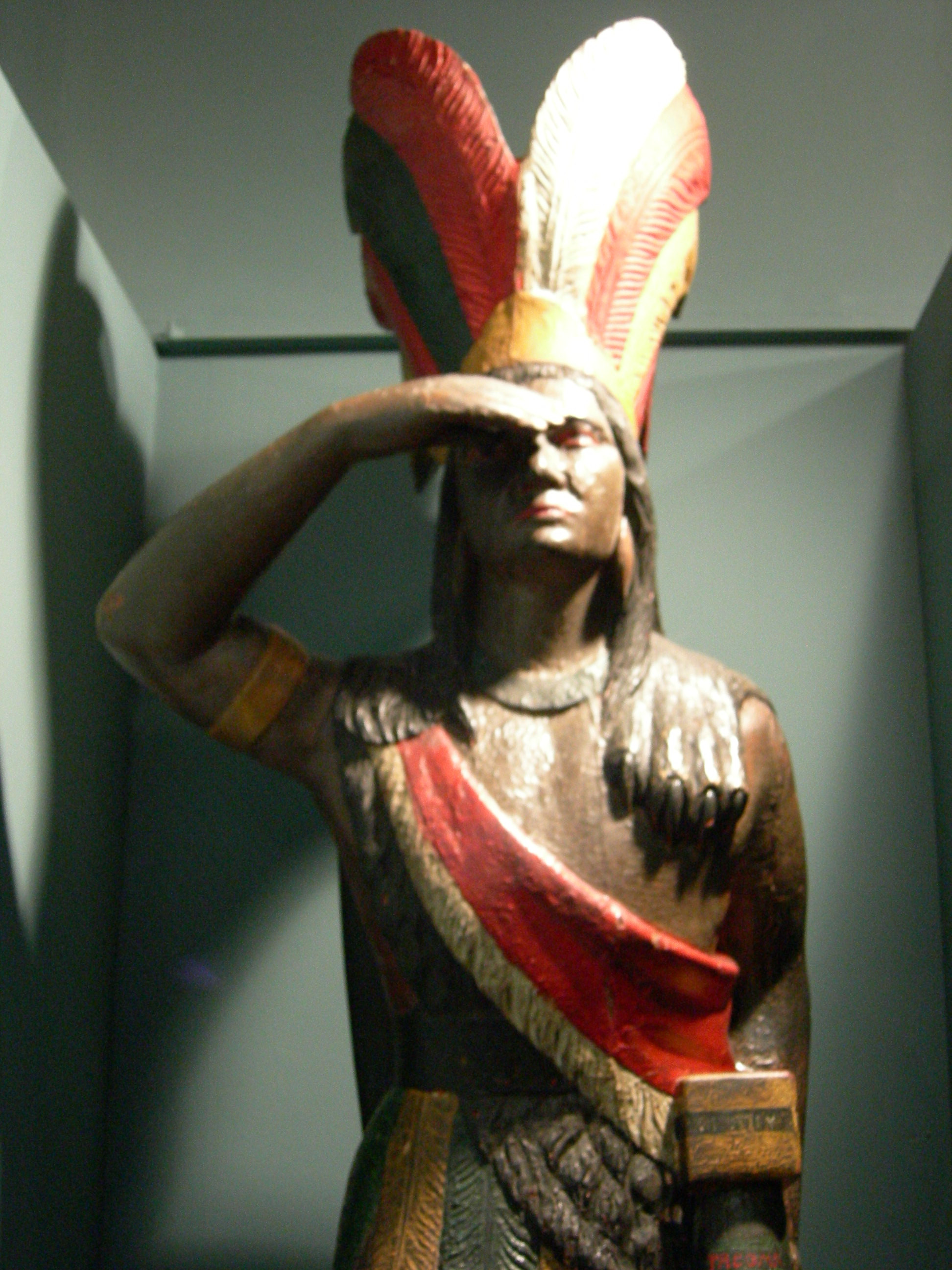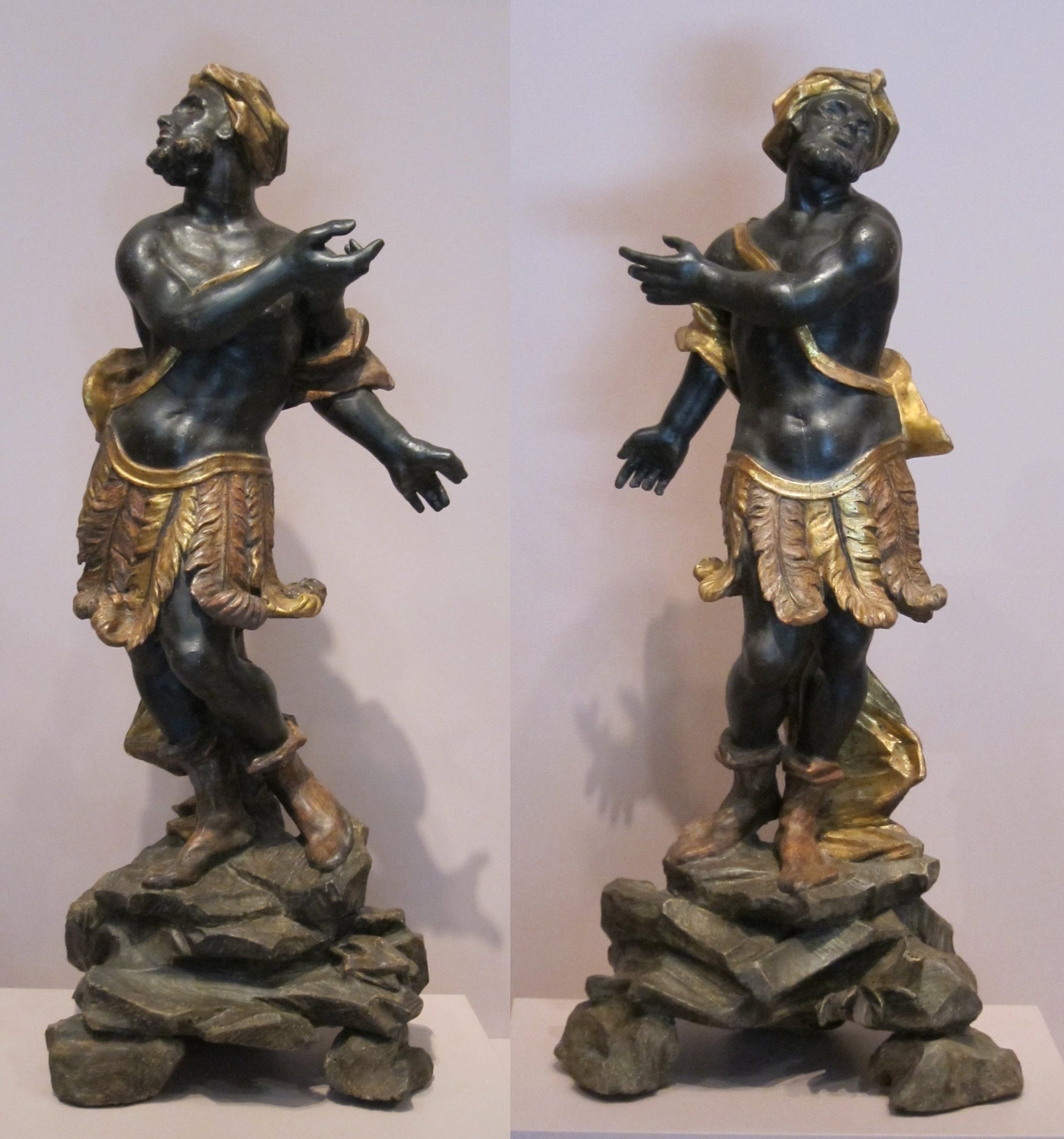|
Concrete Aboriginal
A Concrete Aboriginal, also known as a Neville, is a lawn ornament once common in Australia. The ornament is a concrete statue depicting an Aboriginal Australian, generally carrying a spear and often standing on one leg. The statues were once common in Australia but rarely seen since the 1980s. The fashion for keeping a concrete Aboriginal in the garden was satirised in the Australian 1980s situation comedy '' Kingswood Country'', where the lead character referred to his concrete Aboriginal as "Neville". The name "Neville" was thought to be a reference to Neville Bonner, the first Aboriginal Australian to sit in the Parliament of Australia. See also * Lawn ornament * Lawn jockey *Cigar store Indian The cigar store Indian or wooden Indian is an advertisement figure, in the likeness of a Native American, used to represent tobacconists. The figures are often three-dimensional wooden sculptures several feet tall – up to life-sized. They are ... * Blackamoor * Garden gnom ... [...More Info...] [...Related Items...] OR: [Wikipedia] [Google] [Baidu] |
Lawn Ornament
Lawn ornaments are decorative objects placed in the grassy area of a property. Common lawn ornaments Animal forms: animal statues such as frogs, turtles, rabbits, deer, flamingoes and ducks are cast in plastic or cement. Bathtub Madonna: a statue of Mary the mother of Jesus is placed in a bathtub half buried under the ground. Statues of Mary are most often made of white concrete, but are sometimes painted with a blue garment. Bird bath: a structure designed to hold water for birds to bathe in or drink, generally supported upon a pedestal, is known as a bird bath. Bird feeder: a container for foods such as bird seeds is often designed to look like a miniature house or barn, and may be mounted on a stake, post, or column. Concrete Aboriginal, a lawn ornament once common in Australia. Concrete goose, a popular lawn ornament in the United States. Found object art: items such as bowling balls, toilet planters, and antique farm equipment may be repurposed as lawn ornaments. ... [...More Info...] [...Related Items...] OR: [Wikipedia] [Google] [Baidu] |
Aboriginal Australians
Aboriginal Australians are the various Indigenous peoples of the Australian mainland and many of its islands, such as Tasmania, Fraser Island, Hinchinbrook Island, the Tiwi Islands, and Groote Eylandt, but excluding the Torres Strait Islands. The term Indigenous Australians refers to Aboriginal Australians and Torres Strait Islanders collectively. It is generally used when both groups are included in the topic being addressed. Torres Strait Islanders are ethnically and culturally distinct, despite extensive cultural exchange with some of the Aboriginal groups. The Torres Strait Islands are mostly part of Queensland but have a separate governmental status. Aboriginal Australians comprise many distinct peoples who have developed across Australia for over 50,000 years. These peoples have a broadly shared, though complex, genetic history, but only in the last 200 years have they been defined and started to self-identify as a single group. Australian Aboriginal identity ... [...More Info...] [...Related Items...] OR: [Wikipedia] [Google] [Baidu] |
Situation Comedy
A sitcom, a portmanteau of situation comedy, or situational comedy, is a genre of comedy centered on a fixed set of characters who mostly carry over from episode to episode. Sitcoms can be contrasted with sketch comedy, where a troupe may use new characters in each sketch, and stand-up comedy, where a comedian tells jokes and stories to an audience. Sitcoms originated in radio, but today are found mostly on television as one of its dominant narrative forms. A situation comedy television program may be recorded in front of a studio audience, depending on the program's production format. The effect of a live studio audience can be imitated or enhanced by the use of a laugh track. Critics disagree over the utility of the term "sitcom" in classifying shows that have come into existence since the turn of the century. Many contemporary American sitcoms use the single-camera setup and do not feature a laugh track, thus often resembling the dramedy shows of the 1980s and 1990s rather ... [...More Info...] [...Related Items...] OR: [Wikipedia] [Google] [Baidu] |
Kingswood Country
''Kingswood Country'' is an Australian sitcom that screened from 1980 to 1984 on the Seven Network. The series started on 30 January 1980 and was a spin-off from the sketch on comedy program ''The Naked Vicar Show'' that had featured Ross Higgins as blustering suburban father, Ted Bullpitt. It was written by Gary Reilly and Tony Sattler and produced by their production company, RS Productions. The show won Logie Awards for Best Comedy in 1981 and 1982, and was briefly revived in a spin-off in 1997 titled ''Bullpitt'', although it proved less successful. Premise The show is a family sitcom focusing on the main character, Edward Melba "Ted" Bullpitt (Ross Higgins), a white Australian, conservative, Holden Kingswood-loving putty factory worker and WWII veteran and his interactions with his more progressive wife and two adult children. He lives for three things: his beloved chair in front of the TV, his unsuccessful racing greyhounds Repco Lad and Gay Akubra and his Holden Kin ... [...More Info...] [...Related Items...] OR: [Wikipedia] [Google] [Baidu] |
Neville Bonner
Neville Thomas Bonner AO (28 March 19225 February 1999) was an Australian politician, and the first Aboriginal Australian to become a member of the Parliament of Australia. He was appointed by the Queensland Parliament to fill a casual vacancy in the representation of Queensland in the Senate, and later became the first Indigenous Australian to be elected to the parliament by popular vote. Neville Bonner was an elder of the Jagera people. Early life Bonner was born on 28 March 1922 on Ukerebagh Island, a small island in the Tweed River of New South Wales close to the border with Queensland. He was the son of Julia Bell, an Indigenous Australian, and Henry Kenneth Bonner, an English immigrant. His maternal grandmother Ida Sandy was a member of the Ugarapul people of the Logan and Albert Rivers, while his maternal grandfather Roger Bell (or Jung Jung) was a fully initiated member of the Yagara people of the Brisbane River. According to Bonner, his grandfather was "sort of ca ... [...More Info...] [...Related Items...] OR: [Wikipedia] [Google] [Baidu] |
Parliament Of Australia
The Parliament of Australia (officially the Federal Parliament, also called the Commonwealth Parliament) is the legislature, legislative branch of the government of Australia. It consists of three elements: the monarch (represented by the Governor-General of Australia, governor-general), the Australian Senate, Senate and the Australian House of Representatives, House of Representatives.Constitution of Australia, Section 1 of the Constitution of Australia, section 1. The combination of two elected chambers, in which the members of the Senate represent the States and territories of Australia, states and territories while the members of the House represent electoral divisions according to population, is modelled on the United States Congress. Through both chambers, however, there is a Fusion of powers, fused executive, drawn from the Westminster system.. The upper house, the Senate, consists of 76 members: twelve for each state, and two each for the territories, Northern Terr ... [...More Info...] [...Related Items...] OR: [Wikipedia] [Google] [Baidu] |
Lawn Ornament
Lawn ornaments are decorative objects placed in the grassy area of a property. Common lawn ornaments Animal forms: animal statues such as frogs, turtles, rabbits, deer, flamingoes and ducks are cast in plastic or cement. Bathtub Madonna: a statue of Mary the mother of Jesus is placed in a bathtub half buried under the ground. Statues of Mary are most often made of white concrete, but are sometimes painted with a blue garment. Bird bath: a structure designed to hold water for birds to bathe in or drink, generally supported upon a pedestal, is known as a bird bath. Bird feeder: a container for foods such as bird seeds is often designed to look like a miniature house or barn, and may be mounted on a stake, post, or column. Concrete Aboriginal, a lawn ornament once common in Australia. Concrete goose, a popular lawn ornament in the United States. Found object art: items such as bowling balls, toilet planters, and antique farm equipment may be repurposed as lawn ornaments. ... [...More Info...] [...Related Items...] OR: [Wikipedia] [Google] [Baidu] |
Lawn Jockey
A lawn jockey is a statue depicting a man in jockey clothes, intended to be placed in front yards as hitching posts, similar to those of footmen bearing lanterns near entrances and gnomes in gardens. Because of the prevalence of black lawn jockeys with exaggerated features, the item is often regarded as being symbolic of the racism and racist imagery prevalent in the United States during the eras of slavery and Jim Crow laws. Today, lawn jockeys are often depicted as Caucasian boys to distance the artifact from racial connotations. The lawn ornament, popular in certain parts of the United States and Canada in years past, was a cast replica, usually about half-scale or smaller, generally of a man dressed in jockey's clothing and holding up one hand as though taking the reins of a horse. The hand sometimes carries a metal ring (suitable for hitching a horse in the case of solid concrete or iron versions) and, in some cases, a lantern, which may or may not be operational. Orig ... [...More Info...] [...Related Items...] OR: [Wikipedia] [Google] [Baidu] |
Cigar Store Indian
The cigar store Indian or wooden Indian is an advertisement figure, in the likeness of a Native American, used to represent tobacconists. The figures are often three-dimensional wooden sculptures several feet tall – up to life-sized. They are still occasionally used for their original advertising purpose, but are more often seen as decorations or advertising collectibles, with some pieces selling for hundreds of thousands of dollars. History Because of the general illiteracy of the populace, early store owners used descriptive emblems or figures to advertise their shops' wares; for example, barber poles advertise barber shops, show globes advertised apothecaries and the three gold balls represent pawn shops. American Indians and tobacco had always been associated because American Indians introduced tobacco to Europeans. As early as the 17th century, European tobacconists used figures of American Indians to advertise their shops. In 1667, King Charles II passed a law whi ... [...More Info...] [...Related Items...] OR: [Wikipedia] [Google] [Baidu] |
Blackamoor (decorative Arts)
Blackamoor is a type of figure in European decorative art, from the Early Modern period, depicting a black man. Common examples of items and objects decorated in the blackamoor style include sculpture, jewellery, and furniture. Typically the sculpted figures carried something, such as candles or a tray. They were thus an exotic and lightweight variant for the Atlas (architecture), "atlas" in architecture and decorative arts, especially popular in the Rococo period. The term "blackamoor" or "black moor" was once a general term for black people in English, "formerly without depreciatory force" as the ''Oxford English Dictionary'' puts it. The style is now viewed by some as racist and culturally insensitive. However, blackamoor pieces are still produced, mainly in Venice, Italy. Jewelry and decorative arts In jewelry, blackamoor figures usually appear in antique Venice, Venetian earrings, bracelets, cuff links, and brooches. Blackamoor jewelry is also traditionally produced, bas ... [...More Info...] [...Related Items...] OR: [Wikipedia] [Google] [Baidu] |
Garden Gnome
Garden gnomes (german: links=no, Gartenzwerge, lit=garden dwarfs) are lawn ornament figurines of small humanoid creatures based on the mythological creature and diminutive spirit which occur in Renaissance magic and alchemy, known as gnomes. They also draw on the German folklore of the dwarf. Traditionally, the garden figurines depict male dwarfs wearing red pointy hats. Typically, gnomes stand between . Originating as a decoration for the wealthy in Europe, garden gnomes are now prevalent in gardens and lawns throughout the Western world, among all social classes. They are regarded by some as kitsch. History Ancient predecessors In ancient Rome, small stone statues depicting the Greco-Roman fertility god Priapus, also a protector of beehives, flocks, and vineyards, were frequently placed in Roman gardens. Gnomes as magical creatures were first described during the Renaissance period by Swiss alchemist Paracelsus as "diminutive figures two spans in height who did not like t ... [...More Info...] [...Related Items...] OR: [Wikipedia] [Google] [Baidu] |
Jew With A Coin
The Jew with a coin (, also little Jew (), or lucky Jew ()) is a good luck charm in Poland, where images or figurines of the character, usually accompanied by a proverb, are said to bring good fortune, particularly financially. For most Poles the figurines represent a harmless superstition and a positive, sympathetic portrayal of Jewishness. The motif was first described in articles from 2000, and probably dates back to the early 1990s. While widely recognized the figurines are not the most popular good luck charm in Poland. Scholars offer various interpretations of the motif's nature and origin, though they generally agree that it is used as a talisman for good luck, in particular financial good luck. The figurines have sometimes been criticized and called controversial as they draw on a traditional antisemitic canard of the Jewish moneylender. [...More Info...] [...Related Items...] OR: [Wikipedia] [Google] [Baidu] |







.jpg)